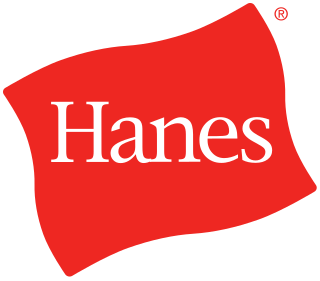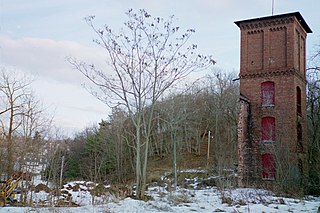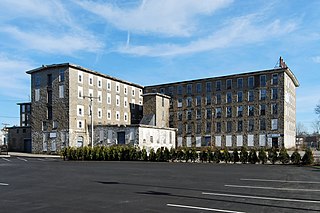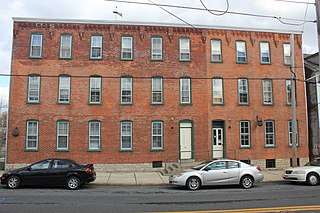
Hanes and Hanes Her Way is a brand of clothing.

The Hop-o'-Nose Knitting Mill was a structure representative of the industrial history of Catskill, New York in the nineteenth century. The mill was built by Wolfe Bros., carpenters, and Mull & Fromer, Masons and Builders, in 1881 at 130 West Main Street. West Main Street is located on the western side of Catskill Creek, while East Main Street is on the eastern side of the creek. The mill was named to the National Register of Historic Places in 1995 as Hop-O-Nose Knitting Mill. It has since been demolished, with the exception of the tower, which remains overlooking a lot full of brick demolition debris.

Wampanoag Mills is a historic textile mill complex located at 420 Quequechan Street in Fall River, Massachusetts. Built beginning in 1871, it is a large and well-preserved example of granite textile mill construction. The site was added to the National Register of Historic Places in 1983.

The Elizabeth Boit House is a historic house at 127 Chestnut Street in Wakefield, Massachusetts.

Byington Mill , also known as the J. A. Firsching & Son Building, is a historic knitting mill located at Utica in Oneida County, New York.

The Huffman Distillery and Chopping Mill is an historic complex of buildings which is located in Somerset Township, Washington County, Pennsylvania, United States.

The Jantzen Knitting Mills Company Building is a building located in northeast Portland, Oregon, USA, listed on the National Register of Historic Places. The picture is of the corner of 19th Ave. and NE Glisan St.

Andrews Bridge Historic District is a national historic district located at Colerain Township, Lancaster County, Pennsylvania, United States. The district includes nine contributing buildings in the rural crossroads village of Andrews Bridge. The buildings were built between 1800 and 1850 and are the old Roop's Hotel, a former mill also known as Dobbin's Store, four dwellings, and three barns.

The Reading Knitting Mills is an historic, American factory building that is located in Reading, Berks County, Pennsylvania.

The H. K. Deisher Knitting Mill is an historic factory building which is located in the borough of Kutztown in Berks County, Pennsylvania.

The Hamburg Historic District is a national historic district located in Hamburg, Berks County, Pennsylvania. The district encompasses 435 contributing buildings in the borough of Hamburg, and is bordered, roughly, by Franklin, Windsor, Walnut, and Second Streets; Quince, Primrose, Peach, and Plum Alleys; and Mill Creek.

Lambert's Point Knitting Mill, also known as The Knitting Mill and Old Dominion Paper Company, is a historic mill building located at Norfolk, Virginia. It was built in 1895, and consists of the central two-story original mill building highlighted by a tall four-story tower. It was augmented in the 1950s by a one-story addition on the south elevation, and by additional one-story additions on the north and west sides of the building. The masonry structure is clad with smooth-finished concrete stucco.

The W. B. Davis Hosiery Mill is a historic industrial complex in Fort Payne, Alabama. It opened in 1884 in the midst of Fort Payne's economic boom, manufacturing building hardware and supplies. The main building, which features Colonial Revival details, is three stories tall, with 12-over-12 sash windows on each floor. An 85-foot (26-meter) chimney has a flared top and corbeled brick course, imitating a doric order column. By 1890, hopes that large quantities of iron ore and other minerals would be discovered in the Fort Payne district proved to be ill-founded. The ABHMC and seven of Fort Payne's other large manufacturers merged in an effort to remain in business, but they were unable to avoid bankruptcy.

The Busiel-Seeburg Mill is a historic mill building in Laconia, New Hampshire, since converted into an office building known as 1 Mill Plaza. This 3-1/2 story brick structure achieved its present configuration in stages, beginning in 1853, and successively altered and expanded through the rest of the 19th century. The business, established by John W. Busiel in 1846, manufactured knitted hosiery, and was one of the first producers of knitwear to use circular knitting machines invented by Aiken and Peppers. The building was listed on the National Register of Historic Places in 1971.

P.H. Hanes Knitting Company is a historic textile mill complex located at Winston-Salem, Forsyth County, North Carolina. The complex includes three buildings. The Knitting Building or North Building was built in 1920–1921, and is a six-story, Beaux-Arts style concrete and steel building sheathed in brick. The Mill Building or East Building was built in 1928, and is a five-story-plus-basement building of concrete, brick, and steel construction. The Warehouse and Shipping Building was built in 1940, and is a six-story steel frame building sheathed in brick. The P.H. Hanes Knitting Company was founded in 1901 by Pleasant H. Hanes, brother of John W. Hanes who founded Shamrock Mills, later Hanes Hosiery. In February 1965, P. H. Hanes Knitting Company merged with Hanes Hosiery. The downtown mill complex closed in 1965. The complex has been converted to loft apartments.

Former Nebel Knitting Mill is a historic textile mill building located at Charlotte, Mecklenburg County, North Carolina. It was designed by noted mill architect Richard C. Biberstein and built in 1927 and expanded in 1929. It is a two-story, reinforced concrete building with a brick veneer and decorative concrete detailing with Art Moderne detailing. The building has a rectangular plan measuring 204 feet across the facade and 182 feet deep. The 1927 portion has a stepped-parapet roofline with concrete coping, while the mill's 1929 part has concrete coping and a simple, crenelated roofline.

Washington Mills-Mayodan Plant, also known as Mayo Mills, Washington Group-Mayodan Plant, and Tultex Corp.-Mayodan Plant, was a historic textile mill and national historic district located at Mayodan, Rockingham County, North Carolina. It encompassed four contributing buildings and two contributing structures in the town of Mayodan. The main spinning mill was built in 1895, and was a three-story, rectangular brick structure with a low-pitched gable roof. The mill was expanded several times between 1897 and 1954. It featured a four-story, one bay, tower with an open belfry at the top. Also on the property were the contributing knitting mill (1911), transformer house, railroad underpass, railroad spur, and frame wood shed. The mill closed in 1999.

West Brothers Knitting Company is a historic knitting mill located in the Westside neighborhood of Syracuse, Onondaga County, New York. West Brothers was built in 1906–1907, and is a three-story, 20 bay by 6 bay, red brick mill building with a raised basement. It is of standard mill construction. The front facade features a three-bay, four-story elevator tower. The West Knitting Corporation moved to Wadesboro, North Carolina in 1928. The mill later housed a corrugated paper container manufacturer, the Gray Brothers Boot & Shoe Manufacturing Company, and most recently a manufacturer of a wide variety of air filters.

The Western Knitting Mills is a former industrial building located at 400 Water Street in Rochester, Michigan. The building has been renovated to serve commercial tenants, including Rochester Mills Beer Company. It was listed on the National Register of Historic Places in 2000.

The Missouri Lumber and Mining Company (MLM) was a large timber corporation with headquarters and primary operations in southeast Missouri. The company was formed by Pennsylvania lumbermen who were eager to exploit the untapped timber resources of the Missouri Ozarks to supply lumber, primarily used in construction, to meet the demand of U.S. westward expansion. Its primary operations were centered in Grandin, a company town it built starting c. 1888. The lumber mill there grew to be the largest in the country at the turn of the century and Grandin's population peaked around 2,500 to 3,000. As the timber resources were exhausted, the company had to abandon Grandin around 1910. It continued timber harvesting in other parts of Missouri for another decade. While some of the buildings in Grandin were relocated, many of the remaining buildings were listed on the National Register of Historic Places in 1980 as part of the state's historic preservation plan which considered the MLM a significant technological and economic contributor to Missouri.
























